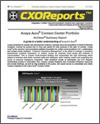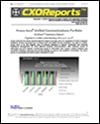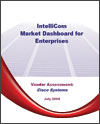December 19, 2008
Universal Service: Uncle Sam's Blank Check
 By Fred Goldstein, ionary Consulting
By Fred Goldstein, ionary Consulting
Good intentions often lead to bad consequences. If the best-laid plans often go astray, what happens to sloppily-laid plans that are not even carefully supervised? While miracles may occasionally happen on 34th Street, they aren’t so common in Washington, DC. And that’s what it would take to fix the Federal Communications Commission’s biggest boondoggle, the Universal Service Fund (USF).
The idea might be a good one if the details were right. The idea behind USF is that telecommunications service is supposed to be made affordable to all Americans, especially residents of rural areas where the actual cost of providing even basic telephone service is high. Universal Service as a concept dates back at least to the 1930s. In those days, AT&T had a monopoly on long distance service, which was seen as a luxury and thus could be priced well its own above actual cost.
AT&T shared their call revenues with local telephone companies, both its own and the “independents”, via a system called Separations and Settlements. The sharing formulas took into account relative investment, so the companies with the most investment per line got a larger share of the pot. A small rural telephone company might get over 50 cents per minute on a 30-cent call, while the mostly-urban Bell Operating Companies got much less. This generated enough funds to finance thousands of small rural telephone companies.
Once long distance competition was enshrined as public policy, Separations was replaced by Switched Access Charges, wherein each local telephone company filed tariffs for its own leg of a long-distance call. The long distance company charged the customer and paid the local telephone companies at both ends. Again, the rurals charged more than the Bells. But high long distance rates became unsustainable in the Internet age. So the Telecom Act of 1996 instead created an explicit Universal Service Fund, run by the Universal Service Administrative Company (USAC)., essentially an arm of the FCC (News - Alert). The idea is to make rural telecom service “reasonably comparable” in quality and price to urban service.
The Act allows USF to be funded by a fee (a tax by another name) placed on “interstate telecommunications services”. This started out in the 3% range, but is now up to 11.4%. Clearly something is out of control. To be sure, the revenue base on which the fee is collected has fallen. Long distance rates are down, and as of 2006, most DSL is no longer classified as “telecommunications service”, so it is no longer subject to the fee. But the real problem is on the cost side.
USF actually contains several different Funds. The Schools and Libraries Fund was the most controversial; it was created in the late 1990s and was nicknamed the “Gore Tax” It disbursed $1.8 billion in 2007, the last year for which totals are available. It mostly pays for schools in low-income districts to purchase Internet access, and a large share of that goes back to incumbent local telephone companies for leased lines. The Low Income Fund pays for Lifeline and Link Up service discounts; it distributed $822M in 2007. The Rural Health Care Fund distributed $37M. But the big one, at about $4.3 billion, is the High Cost Fund. That’s the one where money is shoveled by the trainload into a huge open pit mine.
Subsidies Versus Cross-Subsidies
In the old Bell System, rural telephone subscribers paid the same or lower rates than their urban counterparts, even though costs were higher. This was all handled by the magic of cross-subsidies. In other words, one Bell subscriber subsidized another. Urban subscribers subsidized rural, and to some extent business subscribers subsidized lower-rate residential ones. This kind of works when there’s an absolute monopoly. Economists, however, note that setting prices not based on cost is economically inefficient. And it falls apart pretty quickly in the presence of competition.
USF allocates its funds based on “study areas”, which each represent the service area of a given telephone company in a single state. In general, a telephone company’s average costs for a study area have to be at least 15% above the national average before it qualifies for High Cost Fund (HCF) support. So a company that’s, say, 90% urban and suburban and 10% rural is expected to pay for its rural subscribers via cross-subsidies. Its study areas do not have high average costs. While the Bell companies do receive some HCF support in some states, it’s usually pretty small, typically a few dollars per line per month in their more rural states.
A rural telephone company, though, has no urban areas to cross-subsidize it, so its average per-line cost can be quite high. Hence these companies get the highest direct HCF subsidies. And that’s where things get really screwy.
I’ll Have Him Buy You Lunch
Incumbent telephone company rates are still more or less regulated. Access rates, in particular, need to be regulated, as every telephone company has a “terminating monopoly” on access to its own subscribers. States have deregulated some incumbents’ retail rates, but most rural telephone companies still operate under the old set of rules, called rate of return regulation. Such companies have a rate base, basically the total undepreciated value of their plant in service. Add up their revenues, subtract their expenses, and you get a profit margin. They’re basically entitled to earn profits as a percentage of the rate base, so the bigger the rate base, the bigger the profits.
Rate of return regulation used to apply to all telephone companies; it is still the norm for regulated utilities. When a Bell company wasn’t earning at its approved rate, it would usually ask for a rate increase. State utility commissions would put up a show of concern for the ratepayers, scour the books, and then, depending on the political winds, more or less grant the request. Sometimes the commission would disallow certain expenditures, claiming that the company was trying to pad the rate base in order to inflate its profits.
Nowadays, a rural telephone company’s revenues come from three main sources. Its own subscribers are one, of course. But USF rules are set up to allow rural rates to be no higher than urban ones, and in practice they’re often lower. So subscribers don’t pay their full share of costs. The second source is access revenues; other telephone companies, and especially long distance companies, still pay a higher rate to rural companies than to the Bells. In-state rates are often higher than interstate rates. While FCC-regulated interstate access rates for high-cost rural telcos are usually about two cents per minute, some states allow rates to go over a dime.
Now when you add these two sources of revenue up, a rural telco usually still doesn’t get enough to make a fair rate of return. And access revenues are declining; pending (overdue!) intercarrier compensation reform will probably phase them out over the next few years.
USF High Cost support makes up the difference. So the state regulators don’t have to worry about high rates. The telephone company spends whatever it wants, while the regulators allow them a “reasonably comparable” rate, and somebody else foots the bill. Nice work if you can get it. If the rate base is padded it’s no skin off of the state’s behind. Oh, and that somebody else is us.
This isn’t quite the same thing as a free lunch. It’s like going to the restaurant of your choice and ordering whatever you want, and having a generous friend let you put most of the tab onto his account. But you still pay the price of a fast food hamburger, so it’s not quite free.
Fiber To The Ranch
It isn’t cheap to provide high-quality telephone service in rural areas, especially using wireline technology. Most of the cost of the network is in the outside plant – poles, wires, and other equipment needed to reach subscriber locations. The cost is less per line than per mile. While urban areas may have dozens of homes per mile, and business locations can be much denser than that, rural areas often have densities in the range of one or two homes per mile. That can easily cost about $10,000 per home in capital expenditure, just for Plain Old Telephone Service.
Broadband service is a bit different. Conventional DSL loses speed with distance, and only works at all over about three miles of copper – hardly anywhere in a rural area. Fiber optics don’t have this limit, but new fiber networks are expensive. Some rural telephone companies are building fiber optic networks to their subscribers, providing even better service than most city-dwellers get. If it costs $20,000 or more per home, what of it? That just raises the USF payment.
USAC does not waste precious ratepayer time doing cost-benefit assessments of its HCF recipients’ projects. It does audit them to be sure that the money was spent on allowable projects, but that doesn’t mean that projects must be sensible. Take, for instance, Border to Border Communications, the telephone company in rural Zapata County, Texas. ATT Southwestern Bell is the ILEC in Zapata city, and they don’t get any HCF in Texas. Border to Border has the surrounding countryside, with about 150 phone lines in all spread across 850 square miles. They originally used rural radio systems to provide voice service. Their affiliated ISP also put up a countywide WiFi network, but that wasn’t USF-eligible. Border to Border got a $23 million loan (about $150,000 per line!) from the Rural Utilities Service in 2003 to install a fiber optic network. This is paid back by USF to the tune of $164 thousand per month. That’s over a thousand dollars per line per month.
A few other massive boondoggles have been poster children for USF profligacy. Sandwich Isles Communications was created a few years ago to bring service to Hawaiian Home Lands that had not yet been developed. They have fewer than 2000 lines; they get over $2 million per month. (Need I mention that they were well connected politically as well as telephonically?) Dozens of other carriers get over a hundred dollars per month per line.
Equal Support, Double Payment
USF was created by the Telecom Act, which also made local telephone service competitive. Incumbent LECs are not the only recipients. When the FCC set it up, they also created an “equal support rule” for Competitive Eligible Telecommunications Companies (CETCs). While a handful of CLECs became CETCs, the category really belonged to the wireless indust ry. Under the equal support rule, a CETC got the same amount per line that the ILEC ETC got.
But this didn’t mean that the ILEC loses the money. Since the ILEC got its rate of return, if its costs hadn’t gone down, its USF support didn’t go down. So the CETC and the ILEC ETC got the money. This has been worth a fortune to Alltel, the wireless company that provides fixed-wireless service as a CETC across several western states. But AT&T Mobility and a number of other players also receive equal support. The FCC has proposed ending this rule, and has already begun to lower CETC payments. A current proposal is to phase all CETC support out over five years. This is, perhaps, a baby-with-bathwater approach, as it simply tightens up the ILEC ETCs’ monopoly. Competition should hold costs down, not push them up.
Misaligned Incentives
The largest recipient of USF largesse is AT&T Inc., which got $440M in 2007. About half went to its ILECs, and half to its wireless CETCs. In rural Mississippi, its ILEC got about $100M, and its wireless arm got $63M in equal support payments for competing with its own affiliate. Verizon (News - Alert) got $287M, largely for its ex-GTE ILEC properties, some of which are quite rural. On a per-line basis, though, they were small potatoes. Even AT&T-Mississippi comes to less than $10/line/month. Bells and a few other large ILECs are on price cap regulation, not rate of return. This means that their rates are limited by an annual percentage adjustment, not based on actual costs. Thus they have little incentive to spend more than necessary, and their HCF payments are computed more narrowly. And indeed since price caps became the norm in the early 1990s, they’ve relentlessly cut costs, slashing their staffs and lowering capital expenditures. Verizon’s FiOS (News - Alert) build hasn’t been cheap, but it’s a much smaller effort than the nearly-universal Fiber to the Home coverage that they promised in 1993 in exchange for this “alternative regulation”.
The poorest of the Bells, Qwest (formerly US West), began with the most rural turf. Over the years, they have sold off a number of rural exchanges to smaller companies. Qwest didn’t need the rate base any more; it just needed to control costs. (It only got $70M from USF in 2007.) Rural ILECs who acquire Bell exchanges do not immediately start collecting new HCF support – that would be too easy. But they do eventually collect on new investments.
So this system fails in both directions: Bells have an incentive to do as little as possible in these unprofitable areas, while rural carriers have an incentive to spend with reckless abandon.
Reform Is Difficult
The FCC does have a USF reform docket in the works. For cost control, it just caps incumbents’ draw while it phases out CETCs entirely. But the biggest part of the proposal is to change the way that the money is collected. Instead of taking a uniform percentage of interstate revenues, the current draft plans charge a fixed amount per telephone number in service, and in some versions, a fixed amount per business connection. This reduces the amount paid by long-distance carriers, and puts a new tax on CLECs, especially those who support low-cost VoIP and fax services.
The problem is not in how the money is collected, it’s in how it’s spent. Rural Americans should have good telecommunications. But right now, their carriers get our money for it, with essentially no incentive to control costs. The state commissions don’t care, because the rest of the country is paying.
And USAC is downright proud of how much they spend. Their annual report describes a Mississippi company with 378 subscribers in 62 square miles whose basic rate is $12.20 per month, while the company nets $197.38 per line with the help of USF. USAC’s September disbursements to Georgetown Telephone totaled $75,768. Is this sensible? It includes $16,120 in Local Switching Support. Nowadays, a 500-line switch could be had new for about $120,000. A larger company would simply use a remote module off of a larger regional switch, and for that matter wouldn’t need the whole overhead of a separate company – trucks, technicians, and management. Small ILECs just don’t have to be efficient. And when rural ILEC holding companies like CenturyTel (News - Alert) or TDS buy them, they remain separate study areas, and keep their support.
Why do rural ILECs even need to use wires any more? Wireless technology is capable of providing rural areas with high-quality service, even with DSL-like data rates, at far lower cost. But USAC is directed by the FCC’s Wireline Competition Bureau. They don’t own the radio spectrum, and with the FCC’s internal stovepipes, the Wireless Telecommunications Bureau, which does, has no interest in helping out. WTB’s primary success metric is auction revenues. Radio spectrum license costs are specifically excluded from USF eligibility.
One recently-founded ILEC, Sacred Wind Communications, has built a wireless network to serve several thousand square miles of the Navajo Reservation in New Mexico, a hilly region with very low population density. It has point-to-point backbone radios and several WiMAX (News - Alert) access radios in the new 3650 MHz band. (That band is unusual in that it is licensed non-exclusively, not auctioned off to the highest bidder. But it is not available for use in large areas of the country, especially on the coasts.) Qwest, as the former wireline provider, had not built out to all of these very-high-cost areas. Sacred Wind, as a separate company, receives HCF support for its new construction. Its $275k/month of support, for about 2500 subscribers (some formerly served by Qwest), is a relative bargain compared to what it would have cost using wireline technology. But that’s an extreme case, a truly difficult area to serve where USF funded real innovation. More companies receive USF support to hold down telephone costs in sprawling new suburban subdivisions.
Sprint has proposed the “HCF Plan” for USF reform, which begins by requiring holding companies to consolidate study areas within a state, to allow more internal cross-subsidization to replace USF subsidies. Then it consolidates support across a holding company. Given the very high profit margins of the price-cap Bell carriers, they can certainly afford it. Another reform would take into account unregulated use of the lines. Most DSL, after all, is no longer within the USF system at all, but it certainly brings in a lot of revenue; if that were counted, it would be clear that many ILECs need less support than the USF formulas now allow.
Perhaps there should be a “co-pay” requirement for USF. The carrier’s retail price should reflect, say, 10% of the amount above the equivalent urban cost. So a project that led to a cost increase from $50 to $250/line/month would cost the subscribers an extra $20/month. This would discourage the most profligate expenditures. But realistic projects would still be “reasonably comparable” in cost. After all, city folk don’t get any subsidies from rural areas for our costly housing prices. And perhaps the USF threshold of 15% above average cost is too low a bogey to get into the program; raising it to, say, 20% might raise a few suburban phone rates by a couple of bucks a month, but substantially reduce the program’s scope.
The Universal Service Fund has been treated as a sacred cow for too long. Changing the way the money is collected can only make matters worse. The incoming administration should take a hard look at how the whole program is run, and on the whole set of premises behind it.
Fred Goldstein, principal of Ionary Consulting, writes the Telecom Policy column for TMCnet. To read more of Fred�s articles, please visit his columnist page.
Edited by Greg Galitzine














